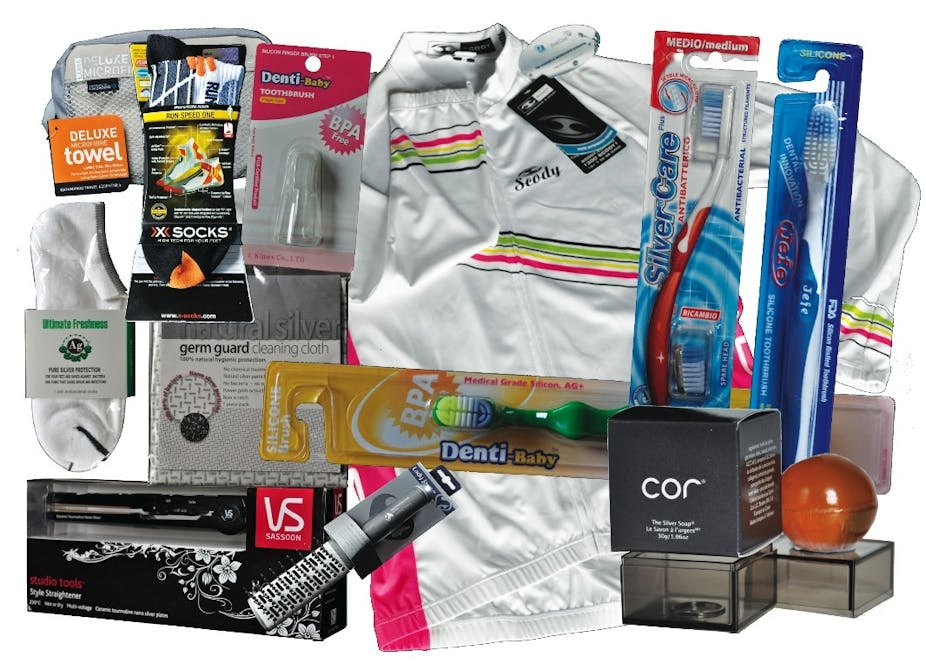The widespread use of nano-silver particles in household items such as toothbrushes, socks and shoe inserts is contributing to the growth of superbugs, according to a Friends of the Earth report released today.
Manufacturers seeking a commercial edge produce “antibacterial” or “odour-controlling” products that contain these tiny silver particles. But widespread use means bacteria may become resistant to silver’s antimicrobial properties, reducing its ability to contain infections in hospitals.
Hatch Stokes, Professor of Microbiology at UTS’ ithree Institute, explains what nano-silver particles are and why their widespread use is of concern:
Silver has long been used in medicine to kill bacteria and prevent their growth. Like antibiotics, silver is an antimicrobial agent and is a really powerful topical treatment for exposed wounds and burns. Dressings are impregnated with with very small particles of silver, and the antimicrobial properties help prevent infection.
Nanoparticle technology is a fairly new way of impregnating or delivering a particular compound to a specific location.
Why is nano-silver being used commercially?
Companies are trying to get a competitive edge by using nano-silver in products such as soap, baby bottles, cleaning cloths and hairbrushes. The idea is that consumers will be attracted to these products, which are marketed as being more hygienic than other lines.
Of course hygiene is important, especially simple measures such as washing your hands, but the notion that you’re going to protect yourself from disease by putting silver nanoparticles in your socks is naive. I don’t think it’s of any therapeutic benefit – it’s just fear-mongering about germs.
What are the likely health implications of the commercial use of nano-silver?
The widespread use of nano-silver in anything from washing machines to bus rails and socks to toothbrushes means we’re providing bacteria with extra opportunities to evolve and develop resistance. Once this happens there is a good chance these bacteria will find their way into hospitals where they can threaten lives.
The fear is that unregulated use of nano-silver in all sorts of objects will lead to the same problem we have with antibiotics.
Over the past few decades, antibiotics have come to be used in situations where they’re not immediately critical to saving the life of someone infected with disease – they’re used very broadly, and have been used inappropriately, particularly in agriculture.
This has given bacteria the opportunity to become resistant to antimicrobials. And because humans travel so much and bacteria move around the environment relatively freely, antibiotic resistant bacteria are spread very broadly.
The use of antibiotics outside a clinical context has indirectly led to antibiotic resistance becoming a problem. And indirectly, it’s led to drug-resistant pathogens infecting patients in hospitals, at enormous cost to lives and health care expenditure.
In most cases, the genes that make those organisms resistant have probably arisen outside the hospital context.
Are nano-silver particles harmful for individual use?
Probably not, but little things that seem unconnected can lead, indirectly, to catastrophic consequences.
If I put on a pair of socks impregnated with nano-silver particles, it’s likely it won’t do me any direct harm, or provide any hygienic benefit. But if enough people put on socks impregnated with nano-silver particles, this is likely to lead to pathogenic organisms acquiring resistance to antimicrobials. And the absence of antimicrobials in a hospital setting could end up killing patients.
The initial connection may seem nebulous but it’s a very real concern, as we’ve seen with the rise of antibiotic resistance.
How should the use of nano-silver technology be regulated?
I don’t have the answers for how this regulatory framework should look. But in making this assessment, it’s important to look beyond the narrow risks associated with the individual use of the product and consider the collective risk as well.

